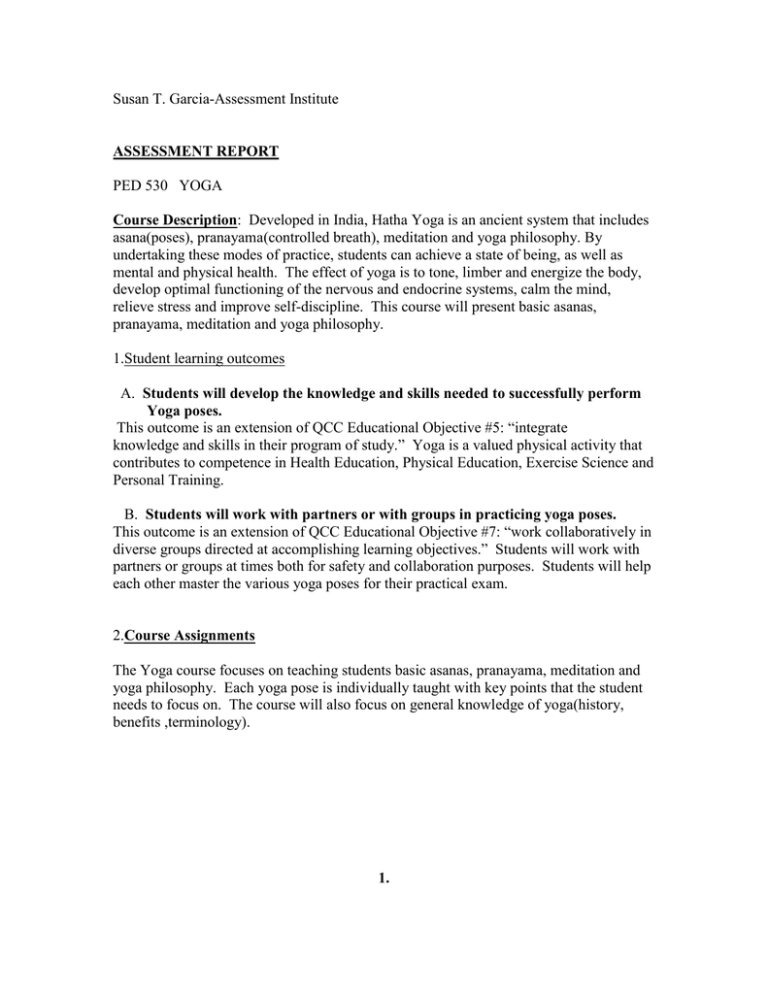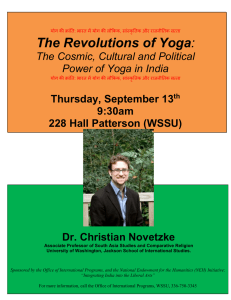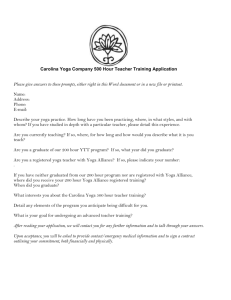Susan T. Garcia-Assessment Institute PED 530 YOGA
advertisement

Susan T. Garcia-Assessment Institute ASSESSMENT REPORT PED 530 YOGA Course Description: Developed in India, Hatha Yoga is an ancient system that includes asana(poses), pranayama(controlled breath), meditation and yoga philosophy. By undertaking these modes of practice, students can achieve a state of being, as well as mental and physical health. The effect of yoga is to tone, limber and energize the body, develop optimal functioning of the nervous and endocrine systems, calm the mind, relieve stress and improve self-discipline. This course will present basic asanas, pranayama, meditation and yoga philosophy. 1.Student learning outcomes A. Students will develop the knowledge and skills needed to successfully perform Yoga poses. This outcome is an extension of QCC Educational Objective #5: “integrate knowledge and skills in their program of study.” Yoga is a valued physical activity that contributes to competence in Health Education, Physical Education, Exercise Science and Personal Training. B. Students will work with partners or with groups in practicing yoga poses. This outcome is an extension of QCC Educational Objective #7: “work collaboratively in diverse groups directed at accomplishing learning objectives.” Students will work with partners or groups at times both for safety and collaboration purposes. Students will help each other master the various yoga poses for their practical exam. 2.Course Assignments The Yoga course focuses on teaching students basic asanas, pranayama, meditation and yoga philosophy. Each yoga pose is individually taught with key points that the student needs to focus on. The course will also focus on general knowledge of yoga(history, benefits ,terminology). 1. 3.Evidence used to determine how well students are achieving the outcomes The yoga poses rubric was used to determine improvement of swilling skills and general yoga poses proficiency. This rubric covers three yoga poses. Tree Pose Cat Pose Downward Facing Dog Also there was a written exam given to determine how much knowledge the students have about Yoga. There was five general questions on the exam. Where was yoga invented? List 5 benefits of yoga What is an Asana? Yoga is done fast while holding your breath Show stick figures of: Cobra, downward facing dog, upward facing dog Twenty –three students from this class were assessed according to the yoga pose rubric and exam. Pretest assessments were conducted and assumed on the third week of the semester. Posttest assessments were conducted on the final class of the course. In a regular semester the Pretest would be given by the second class. The post test would regularly be given at the end of the semester. 4.Analysis and summary of the assessment(see attached pretest and posttest scoring sheets) The results of the assessment show that overall ; students who participated improved in every category from pretest to posttest. Most of the class had no experience in yoga before, only a few. However the large group of students with no experience improved a lot through the semester. This may be attributed to the fact that the students flexibility improved throughout the semester, and was able to practice. If the students stretched everyday in addition to the class they would continue to improve(which is always encouraged). 5.Assessment results affect on student learning It appears that the results of the pre and posttest did show that the class content affected the student learning outcomes. All of the categories showed improvement from the pretest to posttest. The rubric helped many students understand how they were graded on each yoga pose. Also the exam helped the students know what knowledge about yoga was required. Student improvement in yoga depends on extra time stretching and practicing. The students that classified as needs work could be that they are not putting any extra time to stretch or to practice. Students are given the information, demonstration, group instruction, the teacher is always helping the student with corrections if needed and time to practice each pose. The current yoga pose rubric and exam with the pre/posttest seems to be a good assessment for the course materials. 2. One thing that I would like to do different is to add yoga props to help with the students flexibility in the yoga poses. 6.Artifacts Attached are 1. Yoga Rubric 2. Pretest Results 3. Posttest Results PRETEST: 23 Students Pose TREE CAT Downward facing Dog POSTTEST: TREE CAT Downward facing Dog 4:Excellent 4 4 2 3: Good 6 7 4 15 18 10 3 2 3 Yoga Poses 2: Fair 8 4 6 3 1 5 1:Need Work 5 8 11 2 2 5 PRETEST: 23 Students Written Exam 4: Answered all questions 2 3: Answered 3 questions 10 2: Answered 2 questions 10 1: Answered 1-0 questions 1 4: Answered all questions 15 POSTTEST: 23 Students 3: Answered 4 2: Answered 3 questions questions 8 1: Answered 2-0 questions 1 3.







